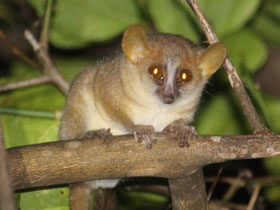Danfoss's mouse lemur (Microcebus danfossi), or the Ambarijeby mouse lemur
Danfoss's mouse lemur (Microcebus danfossi), or the Ambarijeby mouse lemur, is a species of mouse lemur endemic to Madagascar.
Appearance
Microcebus bongovaensis - a species of mouse lemur. It is named after the Danish company Danfoss, which sponsors research on primacy.
Their body length with tail is about 27 cm and their weight ranges from 30 to 60 grams, making them one of the smallest primates. The fur on the back is orange-brown, the belly is creamy white and there is a band of white fur between the eyes.
Distribution
It inhabits dry deciduous forests between the Sufia and Mewarano rivers in northwestern Madagascar. Prior to the description of this species, the mouse lemurs of this area were included in the species Microcebus ravelobensis.
Diet
Dry deciduous forests are poor in resources which limits the species' diet, yet mouse lemurs in general have a quite diverse diet including insect secretions, arthropods, small vertebrates, fruits and flowers. Danfoss’ mouse lemur is said to be particularly fond of bananas as it is often the food of choice in captures for research projects.
Reproduction
Their reproduction period can be quite long from may to October, even sometimes November and depends less on seasons than other lemur species since their habitat is near a humid, low-altitude forest with more resources available to them. They share the same reproduction schedule as others such as M. ravelobensis and M. bongolavensis. Their reproduction generally starts around 1 years old and gestate for a bout 60 days. Most females give birth every year, creating a new generation of Danfoss's mouse lemur approximately every 1 to 5 years.
Conservation
Human activity especially agriculture is the main responsible for loss of habitat which created fragmented forested. They present an important issue in the conservation of the species because it isolates them in small groups creating a bottleneck effect which causes significant reduction of genetic diversity since they can only reproduce within a small number of individuals. Their population collapse is estimated to have started about 100 to 85 years ago and represents the disappearance of around 11 thousand individuals. The Bayes Factor analyses demonstrates a correlation between the appearance of bottlenecks and the two most recent periods of human colonization.
Status
According to the IUCN, the species is currently considered vulnerable since 2018 but was considered endangered in 2014. It is complicated for organizations to put in place conservation plans for this species because of its limited access and the lack of information they have on it. However, the IUCN is quite clear on the critical condition of the species. It states that if no conservation measures are put in place they predict the entire loss of the Danfoss’s mouse lemur habitat in 2080 by only considering climate change. Without any adapted habitat, the species is unlikely going to survive much longer after. Considering their current status and the rate at which the species is decreasing, it is predicted to be extinct before, given that their main threat is human activity and not climate change. Today, most organizations agree that the current measures are not sufficient. Amongst them are international legislation and international management and trade controls. In addition, only one fragmented forest, Bora, is part of the National Network of protected areas.

















































